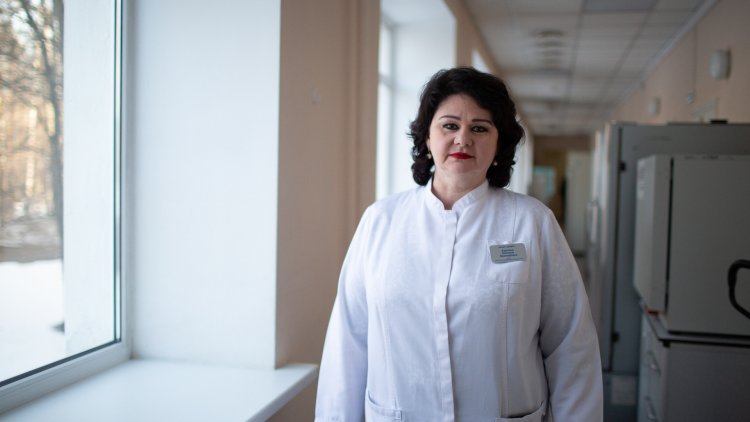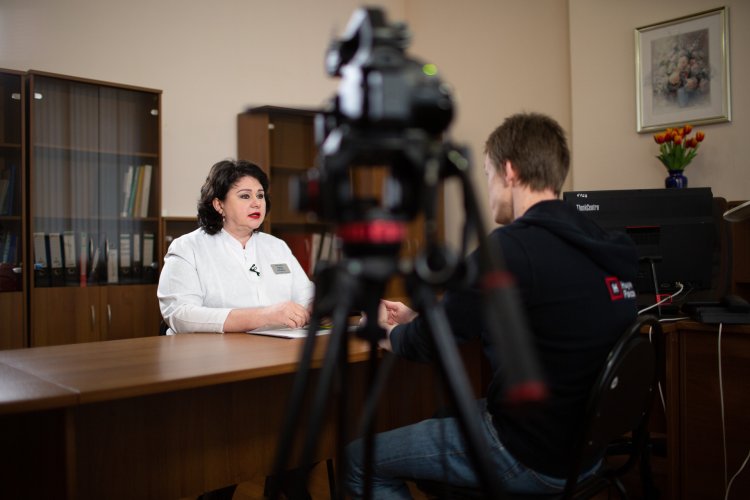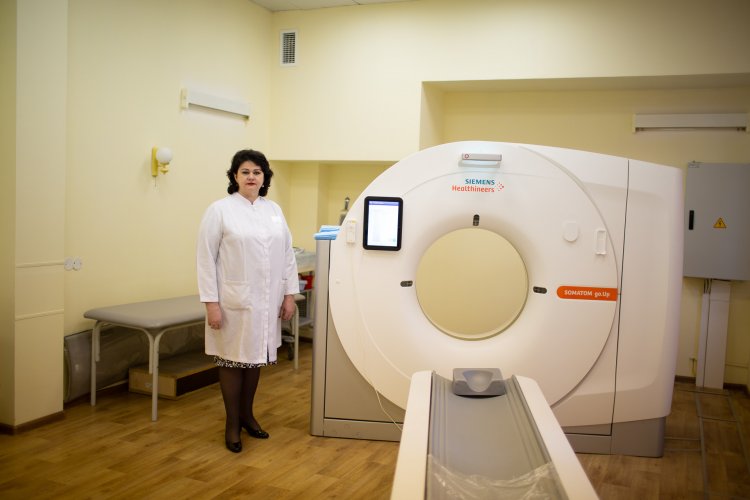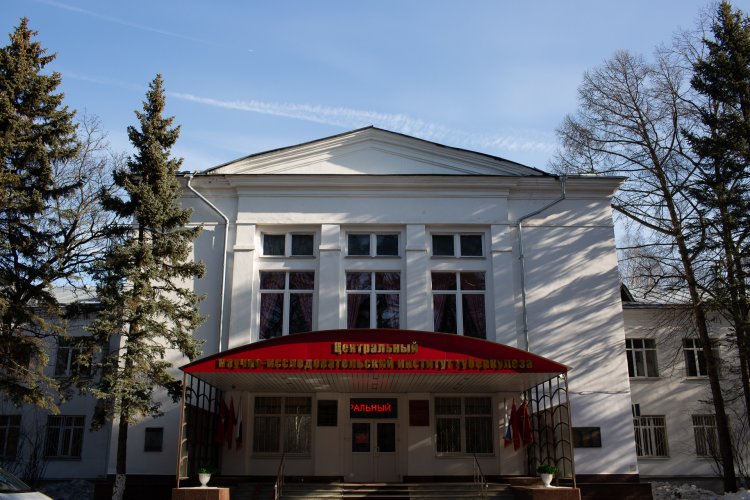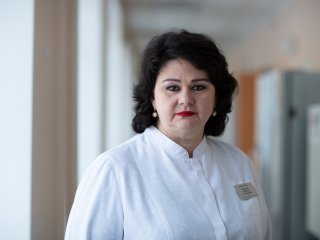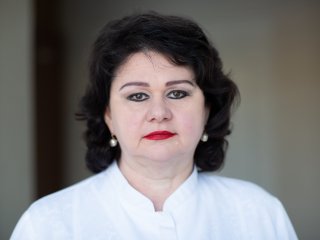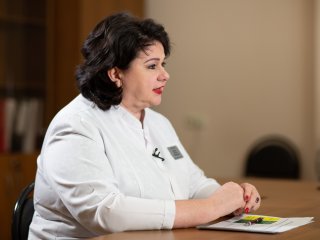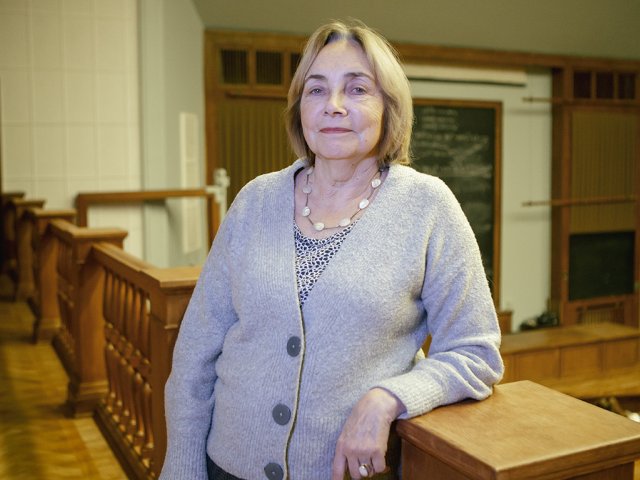On March 24, 1882, the German microbiologist Robert Koch announced his discovery of the causative agent of tuberculosis. In 2022, 140 years passed since the discovery of Mycobacterium tuberculosis, and on March 24, World Tuberculosis Day is commemorated.
Deputy Director for Scientific Work of the Central Research Institute of Tuberculosis, Doctor of Medical Sciences Natalia Leonidovna Karpina tells us about modern approaches to tuberculosis treatment and diagnostics and about its connection with COVID-19.
Deputy Director for Scientific Work of the Central Research Institute of Tuberculosis, Doctor of Medical Sciences Natalia Leonidovna Karpina
Photo: Andrey Luft, Scientific Russia
– Tuberculosis has not yet been defeated despite the fact that the causative agent of the disease was discovered 140 years ago. Over the years, mortality has been rising and falling, but the disease is still a global problem. How would you evaluate the current epidemiological situation with tuberculosis?
– Discovering the causative agent of tuberculosis has been a great breakthrough in science and medical practice.
A lot of time has passed since that moment. For some time, we actually thought that we would defeat tuberculosis – streptomycin and rifampicin were discovered and became quite effective tuberculosis drugs. But the tuberculosis bacillus has also changed over time: the share of drug-resistant cases is currently growing. In clinical practice, we are increasingly more likely to encounter patients with tuberculosis, the causative agent of which is resistant to all known anti-tuberculosis medications. This is a big problem and one of the reasons why we have not defeated tuberculosis yet.
In Soviet era, an anti-tuberculosis service was established in our country. It should be noted that the specialty of phthisiologist exists only in the post-Soviet space. There is no such specialty in foreign countries, and tuberculosis patients are treated by pulmonologists. I believe that a phthisiologist should be competent in all issues related to respiratory diseases, since the doctor can leverage a broad outlook and deep knowledge of respiratory pathologies to build a differential diagnostics sequence and make the correct diagnosis in a timely manner.
To treat tuberculosis, an integrated approach is used – a combination of etiotropic treatment (medications that directly act on the causative agent of the disease), pathogenetic therapy (influences various links of tuberculosis pathogenesis), and surgical treatments. Each patient undergoes individualized treatment, which accounts for drug sensitivity of the pathogen and tolerability of the medications. Today, it is not enough for phthisiologists to know that a person has tuberculosis – they require the data on the pathogen drug sensitivity, because otherwise it is impossible to prescribe adequate therapy.
Nowadays we rarely encounter tuberculosis forms described in the early twentieth century. Tuberculosis has changed, and its diagnostics has changed. For example, when phthisiologists identified acid-resistant microorganisms in diagnostic samples back in the 1980s, they firmly believed that it was tuberculosis, but now, when a competent doctor discovers acid-resistant microorganisms, they must find out whether the sample contains the Mycobacterium tuberculosis complex DNA. If the Mycobacterium tuberculosis complex DNA is not detected, it is possible that the patient suffers from non-tuberculosis mycobacteriosis.
Our Institute successfully operates a microbiological reference laboratory, which conducts the full range of modern microbiological assays for diagnosing tuberculosis and non-tuberculosis mycobacteriosis. What is very important, we can determine the drug sensitivity to all modern anti-tuberculosis medications and monitor the treatment efficacy.
Yes, we have not defeated tuberculosis in 140 years. The causative agent of the disease has changed, people have changed. But we have made tremendous progress in diagnostics, treatment and prevention of the disease.
The tactic of active tuberculosis detection has always worked in our country – the search for patients during examinations conducted regardless of presence or absence of tuberculosis manifestations. To do this, preventive check-ups, fluorography of the chest, and tuberculin diagnostics are performed at a certain intervals.
Photo: Andrey Luft, Scientific Russia
– In terms of detection, it is probably possible to compare tuberculosis with oncological diseases, when it is important to detect cancer at an early stage.
– That's right. If the disease is detected early, the expected treatment outcome is the most favorable. With timely diagnosis of tuberculosis, limited forms of the disease are more likely to be diagnosed, and if the drug sensitivity of the pathogen is established, it significantly reduces the treatment duration and increases its efficacy.
Tuberculosis is a curable disease. But it is necessary to identify it in time and treat it correctly. The patients' treatment compliance is also important. It should be understood that tuberculosis treatment is not easy, it can include either 4 or 6 main medications, plus additional pharmaceuticals to prevent side effects. Some patients perceive the number of medications negatively – indeed, there are a lot of them.
– Is tuberculosis usually treated in an outpatient setting or do the patients stay in hospital?
– In Russia, both treatment types are used. If the patient does not discharge the bacteria, then a TB center can provide outpatient treatment for some forms of tuberculosis.
Tuberculosis treatment takes a long time – drug-sensitive tuberculosis is treated for six months with two months of intensive therapy. If drug-resistant tuberculosis is diagnosed, treatment can last for 18 or 24 months. Obviously, long-term treatment is hard. In our institute, a group of psychologists works with the patients, they help the patients fight the disease. It is rare to meet people who take the diagnosis calmly. For many patients it is a shock, stress, and you should help the person cope with it.
– What is modern tuberculosis diagnostics like?
– Tuberculosis diagnostics is a complex process. If changes are detected in the lungs – it does not matter whether they are focal changes, infiltrative changes, or decay cavities – the doctor builds a differential diagnostics row. After all, the X-ray image may indicate several diseases. Of course, high-resolution computed tomographs, which are available in hospitals today, seriously help the doctors, but it is impossible to be absolutely sure that the patient has tuberculosis based on X-ray images alone. The diagnosis should be confirmed etiologically – by identifying the pathogen or morphologically – by examining surgical or bronchobiopsy samples. Only after such tests can we say that the person really has tuberculosis inflammation.
The institute uses a three-stage diagnostic program, which includes a comprehensive clinical radiological examination, a microbiological examination, bronchoscopy with a complex of biopsies, including innovative ones, as well as diagnostic surgeries.
Photo: Andrey Luft, Scientific Russia
– When did the doctors begin not only to rely on images when making a diagnosis, but also to conduct comprehensive examinations?
– Our teachers, who laid the foundations of phthisiology, always sought to make diagnoses based on all the data combined. But they had no technical means.
New examinations emerged along with the technological breakthrough. Computer tomographs are a great step forward. Another stage is virtual bronchoscopy. The next level is radioisotope methods, which we use both for diagnostics and to evaluate treatment efficacy. Modern microbiological diagnostics of tuberculosis, decoding of the Mycobacterium tuberculosis DNA, sequencing – all these things are harmonious development of technologies that facilitate tuberculosis diagnostics. However, it is not enough to have the results of high-tech examinations, it is necessary to interpret them correctly in order to make the correct diagnosis.
– Tuberculosis is becoming resistant to drugs. What kind of work is being done to defeat this resistance?
– New, modern medications are entering phthisiology. In particular, these are medications that were previously used for other diseases, for example, leprosy, but showed their efficacy for tuberculosis. We stopped using some broad-spectrum antibiotics altogether, since the pathogen developed total drug resistance to them.
To combat the drug resistance, it is necessary to synthesize new medications, but this is a long process – it takes years from finding a new molecule to creating a medication and introducing it into clinical practice.
– What alternatives and additions to drug therapy do phthisiologists use today?
– Etiotropic treatment, that is, anti-tuberculosis therapy, is an indispensable base. But there are also extremely difficult cases when we encounter total resistance of the pathogen to anti-tuberculosis drugs. In such situations, we have learned to select a treatment regimen and to apply methods that increase treatment efficacy.
In particular, we use collapse therapy methods – artificial pneumoperitoneum, artificial pneumothorax. When such methods are used, the lung tissue collapses, which reduces its stretching and creates favorable conditions for healing.
In recent years, we have been using valvular bronchial blocking – during bronchoscopy, an endoscopist installs a valve in the bronchus to drain the lung cavity, then the cavity collapses and healing progresses faster.
Such treatments are used within the individual approach to patients. One patient can be successfully cured with medications alone, in other cases we additionally use valvular bronchial blocking and collapse therapy, some patients require surgery. Moreover, there are patients with bilateral destructive tuberculosis. In these cases, surgery is performed on one lung, then on the other.
A breakthrough in surgical treatment of respiratory diseases and tuberculosis in particular occurred when it became possible to perform video-assisted thoracoscopic surgeries. We have moved away from large skin incisions we performed back in the 90s. I witnessed this period when I started working in the surgical department of the institute. For example, incision up to 35 centimeters long was performed for posterior access to the lung. Now the doctors perform video-assisted thoracoscopic surgeries that require a small incision. It is not just for cosmetic effect: with this approach, injury is minimized, and healing takes place faster.
Currently, silicone implant filling is used in surgical treatment of destructive tuberculosis. This operation is associated with minimal traumatization and yields an excellent therapeutic effect.
Today, patients can be cured of tuberculosis, even if the disease was detected late or treated ineffectively on the early stages.
In 2015, in order to defeat tuberculosis, the World Health Organization adopted the End TB strategy. This strategy assumed that each year the global incidence of tuberculosis would decrease by 6-10%, and mortality – by at least 10%. That is, by 2025, tuberculosis incidence should decrease by 35%, mortality – by 50%.
– Is it possible?
– The strategy was adopted in 2015, and the COVID-19 pandemic began in 2020. During the lockdown, access to medical care was limited, so detection of tuberculosis in the world decreased by 18%; among children and adolescents – by 24%. In Russia – by 14%.
According to the WHO, it was the COVID-19 pandemic that reversed the long-term plans to counter tuberculosis. In 2020, the global results on reducing tuberculosis incidence and mortality returned to the 2017 level. Compared to 2019, the worldwide tuberculosis death rate increased by 100,000 people in 2020. The WHO predicts that this delayed effect will grow.
In terms of reducing tuberculosis incidence and mortality, Russia is moving forward at a faster pace. In 2000, tuberculosis incidence was 90.4 per 100,000 population, and in 2020 – 32.4 per 100,000 population, i.e., the incidence became almost three times lower. In 2000, tuberculosis mortality was 20.6 per 100,000 population, and in 2020 we saw significant progress – this figure was 4.5 per 100,000 population.
How did we achieve such results? Of course, the positive impact of the state support for all anti-tuberculosis measures, as well as provision of anti-tuberculosis drugs and medical equipment, contributed to this progress. In addition, the very structure of the anti-tuberculosis service and its ability to work as a single organism allowed to achieve significant results in countering tuberculosis.
And it was the tuberculosis service that turned out to be the readiest for the COVID-19 pandemic: for a phthisiologist, distancing up to one and a half meters, isolating a sick person and using personal protective equipment are obvious preventive measures.
I would like to say that in 2021, our institute celebrated its 100th anniversary. We are proud of the institute and its history, many phthisiology achievements were made within these walls. It is also true for surgical treatment of tuberculosis. Thus, one of the best-known Soviet surgeons, the founder of thoracic surgery and an outstanding scientist – Lev Konstantinovich Bogush – worked at our institute.
– Can violations of patient routing and limited access to medical care during the pandemic cause an explosive increase in neglected cases of tuberculosis in the future?
– During the pandemic, the phthisiological service, including in Moscow, took up the fight against COVID-19. Many TB centers in the country were repurposed for treating the novel coronavirus infection. But phthisiologists were able to organize their work in such a way, so as not to abandon the preventive measures and to ensure that the patients received treatment timely. In 2021, the population coverage with scheduled examinations increased, and today the gap that appeared in 2020 has been eliminated.
– In 2021 it had been 100 years since BCG was created, but it remains the main anti-tuberculosis vaccine today. Is it necessary to replace BCG with a more modern vaccine?
– There are attempts to introduce new tuberculosis vaccines.
The BCG vaccine has proven to be a highly effective medication with minimal side effects.
Before BCG vaccination was introduced, children around the globe had a high mortality rate from tuberculosis meningitis. BCG vaccination reliably protects the child from severe generalized tuberculosis – even if the child had a contact with a tuberculosis patient, they can still overcome the infection. But if this does not happen, the vaccinated child will only face limited tuberculosis, and we will be able to treat the patient effectively. Therefore, the doctors are satisfied with the BCG vaccine for now. The search for new vaccines is underway, but there is still no medication that could really replace the BCG.
– What connection did doctors notice between COVID-19 and tuberculosis during the two years of the pandemic? How does coronavirus infection affect tuberculosis complications, and to what extent does tuberculosis affect COVID-19 severity in patients?
– This issue has been studied in our institute and in other institutions.
In children and adolescents with a combined infection – tuberculosis and COVID-19 – who received or are receiving anti-tuberculosis therapy, we did not notice any negative effects: neither development of tuberculosis complications nor a more severe course of the novel coronavirus infection. In adults with tuberculosis, in isolated cases, the novel coronavirus infection was severe, but we cannot reliably say that it was due to tuberculosis. The Vrach journal published an article on the results of surgical treatment of patients with tuberculosis after the novel coronavirus infection. Examination of the morphological samples showed that tuberculosis did not progress in these patients. Based on this, we concluded that if a patient with tuberculosis receives the required treatment, COVID-19 does not have any significant influence on the disease course.
There were isolated cases when patients with COVID-19 did not know about tuberculosis and did not take anti-tuberculosis therapy (tuberculosis was initially detected during an examination for COVID-19). In such patients, we noted both destructive processes in the lungs and such complications as hemoptysis.
In isolated cases, we observed patients who had tuberculosis before (15-20 years ago) and then contracted COVID-19; in these patients, we did not notice any significant effect of COVID-19 on the tuberculosis course.
– What approaches to rehabilitation after tuberculosis do phthisiologists use today?
Health resort treatment, work therapy, psychotherapy – such rehabilitation has a huge impact on treatment of tuberculosis patients. These methods were developed decades ago and they are still effective.
Modern rehabilitation trends are physical activity, diet therapy, and psychological assistance for the patients and their relatives.
At the institute, patients undergo rehabilitation in therapeutic departments, while the institute branch in Kaspiysk (Dagestan) is working on establishing a rehabilitation center for patients with respiratory diseases.
Rehabilitation is a long process consisting of many stages. And the first stage is at the patient's bedside.
- To summarize: tuberculosis is curable today at almost any stage, but special attention should be paid to its diagnostics and early detection during the COVID-19 pandemic.
- Exactly.
